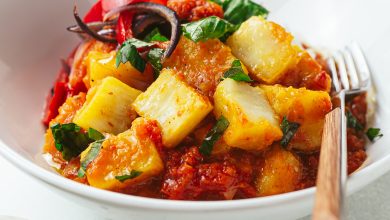Waakye (Ghanaian Rice and Beans Dish)
Introduction:
Waakye is a cherished and iconic dish from Ghana, combining rice and beans into a hearty, flavorful meal that is both satisfying and versatile. Traditionally, the rice is infused with a deep, earthy color from dried millet leaves, which gives the dish its signature look and adds an extra layer of rich flavor. Waakye is often served with various accompaniments, making it a perfect dish for any occasion, from casual lunches to festive gatherings. This recipe highlights the simplicity and depth of Ghanaian cuisine, offering a comforting, nutritious meal that brings a taste of West Africa to your table.
Ingredients Table:
| Ingredient | Quantity |
|---|---|
| Rice | 2 cups |
| Dried beans (any variety, preferably black-eyed peas) | 1 cup |
| Dried millet leaves | A handful (for coloring) |
| Salt | To taste |
Instructions:
-
Prepare the Beans and Millet Leaves: Begin by rinsing the dried beans thoroughly. In a large pot, combine the beans and dried millet leaves. Add enough water to cover the beans completely and bring to a boil. Let the beans simmer over medium heat until they are tender, which usually takes about 45 minutes to an hour.
-
Cook the Rice: Once the beans are tender, remove the millet leaves. Add the rice to the pot of beans along with the salt. Stir to combine, then add enough water to cover the rice by about an inch. Bring to a boil, then reduce the heat to low. Cover and cook for about 20-30 minutes, or until both the rice and beans are cooked through and the water has been absorbed.
-
Serve: Waakye is traditionally served with a variety of sides. Common accompaniments include shito (a spicy pepper sauce), stew, fried onions, and yaji (a spicy pepper and ginger condiment). Serve the rice and beans alongside your choice of toppings for a complete meal.
Allergen Information:
This recipe contains rice and beans, which are naturally gluten-free and suitable for most individuals with gluten sensitivity. However, it’s important to check the specific ingredients in your seasoning or condiments (such as shito or yaji) to ensure they are free from allergens such as soy or fish. If you’re serving Waakye with fried onions or any other toppings, consider any food allergies or sensitivities your guests may have.
Dietary Preferences:
Waakye is a great option for those following a vegetarian or vegan diet, provided the toppings and sides you serve with it are plant-based. It is also naturally gluten-free and can be part of a low-fat, high-fiber diet due to the beans and rice. The dish is rich in carbohydrates, making it a great choice for those needing sustained energy throughout the day.
Advice:
Waakye can be a bit time-consuming to prepare, especially when making the beans from scratch. If you’re short on time, you can always use canned beans to speed up the process. Be sure to cook the rice and beans thoroughly to achieve the perfect texture, and don’t skip the millet leaves, as they add a distinct color and flavor to the dish that sets Waakye apart. For an authentic experience, serve it with a spicy accompaniment such as shito or fried plantains.
Conclusion:
Waakye is more than just a dish; it’s a symbol of Ghanaian culinary culture and heritage. With its simple yet delicious blend of rice, beans, and vibrant color, this dish is a must-try for anyone looking to explore West African flavors. Whether you enjoy it with spicy condiments or a savory stew, Waakye is sure to satisfy your appetite and introduce you to the heartwarming tastes of Ghanaian home cooking. Enjoy!



